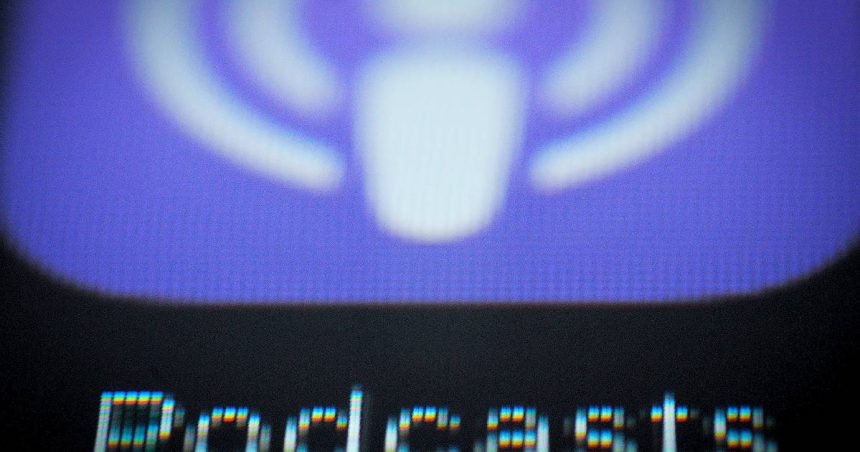In the year 2025, podcasts feel inescapable. Everyone’s a podcaster, and everything is a podcast.
It wasn’t always like this.
The birth of the podcast is largely tied to the creation of the RSS audio feed in 2001, though the term “podcast” wasn’t coined until 2004. The following year, Steve Jobs declared that “Apple is taking podcasting mainstream” when the company made podcasts accessible in iTunes (it’s now celebrating the 20-year milestone with a curated list of 20 of the most impactful shows from the past two decades). But the true mainstreaming of the medium didn’t really happen until nearly a decade later, when Apple released a standalone podcast app in 2012, followed by the debut of megahit Serial in 2014.
After that, podcasting was officially supercharged. Podcasts became all but essential advertising channels for major tech and media companies, with podcast ad revenue climbing past the $1 billion mark in 2021, and seemingly everyone with a platform—from actors to ad execs—getting behind a microphone.
It hasn’t been all rainbows and sunshine in the podcast industry, though. In recent years, layoffs and advertising slowdowns have plagued the space, indicating a potential thirst for change.
Enter video podcasts, which have given consumers a different way to engage with the format—and have unlocked a plethora of video advertising opportunities for creators and hosting platforms.
“What the consumer wants is that foreground-background flexibility,” Emma Vaughn, global head of advertising and content business development at Spotify, told Marketing Brew. “If you’re listening, and all of a sudden you want to see the expression on the face of the interviewee, you can just turn your phone around, then put it back in your pocket. Even if you did that for two minutes, the fact that the video is available there increases overall consumption. [Video] really is like a tide that lifts all boats.”
If video killed the radio star, could it do the opposite for the podcast host?
What’s in a name podcast?
Video content has become so ubiquitous in podcasting that today, the most commonly accepted definition of a podcast is a “recording of people discussing any topic on YouTube that is also available as [an] audio-only show elsewhere,” according to a recent survey of more than 4,000 Americans ages 12 and up conducted by Edison Research and podcast ad agency Oxford Road. About half (52%) of respondents went even further, saying that they considered “content that is only available on YouTube in video form” to be podcasts.
The lack of agreement on a definition “has the ability to be a problem,” Oxford Road founder and CEO Dan Granger said, “but I choose to see it as an opportunity.” For one, he said, video helps with the discovery of new content, which has long been an issue for the audio-based medium.
“If I press play on a 90-second podcast trailer, put the phone in the center of the table, and stare into your eyes for 90 seconds, we wouldn’t hang out anymore,” Bryan Barletta, founder of the podcast trade association Sounds Profitable, said. “There are some aspects of getting people’s attention that do need visuals.”
That could be one reason why most major audio companies are pushing further into the video game. At the end of last year, Acast, a global podcasting platform and tech company, acquired Wonder Media Network, a creative podcast studio, in an effort to expand branded content and video production capabilities, Greg Glenday, Acast’s CEO, told us.
With more creative support, video has become a central part of Acast shows, and it’s brought different types of creators into the company’s fold. “We’ve got some YouTubers that are mostly YouTubers that also do podcasting, and then we have some podcasters that are learning how to do video on YouTube and other places,” Glenday said.
Even companies like NPR and SiriusXM that started in radio are embracing podcast video. Stephen J. Dubner, host of the podcast Freakonomics Radio, which has amassed hundreds of millions of downloads and celebrates its 15th anniversary this year, told Marketing Brew that he, too, has “toyed with adding a small video component,” building on a growing YouTube audience for the show, which is currently only available as audio-only on that platform.
“YouTube is the most-watched platform in the world,” Adam Sachs, SVP of podcast content at SiriusXM, said. “It’s where the media audience is more than anywhere else…Putting your podcast up there gives it a chance of being served to so many more people than it would have had you just been in the closed RSS ecosystem.”
Get marketing news you’ll actually want to read
Marketing Brew informs marketing pros of the latest on brand strategy, social media, and ad tech via our weekday newsletter, virtual events, marketing conferences, and digital guides.
As video use gets more widespread in podcastland, Glenday said that the additional ad opportunities are attractive to both creators and advertisers—but he noted that breaking into video isn’t always the right fit. Business podcasts aren’t often significantly enhanced with visual assets, he said, and he noted that some, like podcast pioneer Marc Maron, have said that adding a filmed component can change the feel of a conversation and make it seem more scripted—although, he added, the security of a more contained discussion could also be alluring to brands.
“It depends on the show and the quality of it, and if they know what they’re doing,” Glenday said. “If they’re showing a lot of charts or highlights, if it’s a recap and they need to show something, then great, do video. And we’re happy to sell both, so we’re trying not to push [creators] one way or the other.”
Roll the (measuring) tape
While video can offer another way to monetize podcasts, stretching the medium further across platforms is amplifying another obstacle: measuring ad campaigns, which was already seen as being difficult in the podcasting space.
Traditional podcast measurement relies on a pixel-based attribution system, but video platforms use different measurement tech and metrics, which has led to “some frustrations by buyers,” said Gina Garrubbo, president and CEO of National Public Media, NPR’s exclusive sponsorship arm.
“You have a show distributed to multiple points of distribution, and each of those points of distribution requires its own methodology,” Granger said. “There’s always been ways that advertisers had to figure out assigning credit between channels, but never so much for the same assets…There’s a whole new layer of fragmentation that is making this job harder to do for everybody, and some advertisers are saying, ‘I don’t need more problems in my day. Just give me something that I understand.’”
Agencies like Oxford Road are trying to help marketers by “doing the math to triangulate” the different metrics—whether that’s an RSS download, a stream on Spotify, or a view on YouTube—but with no standard metric across platforms, podcast measurement remains predicated on some assumptions, Granger said, leading to some of that advertiser frustration.
That means some companies are emphasizing some podcast ad formats over others like media and investment company FlightStory, which has identified visual, baked-in ads as its most efficient advertising format. Christiana Brenton, FlightStory’s chief revenue officer, told us that she believes consumers have already signaled their desire for video-first podcasting content, and focusing on video-first ad buying is key to understanding and improving performance. But if podcast companies don’t have the technology to dig into video,she believes that creators and advertisers could be left behind on outdated RSS reliance.
“We have these big companies that don’t have ad stacks that enable video-first distribution,” Brenton told us. “I would really challenge a lot of the creators to really critically assess the incentives at play with some of the existing marketplaces, because if there’s any company that specializes in the creator economy or podcasting that is not advising creators to be video-first and to adopt baked-in read formats, they’re ultimately really limiting their audience growth and also limiting the ad effectiveness.”
Even amid the challenges, there continues to be advertiser demand for podcasts of all kinds, whether that’s audio-only or contains video.
“Anytime you see the growth, both from the user numbers, but also the zeitgeist…advertisers are going to flock to that, too” YouTube VP of Partnerships Tim Katz said. “We’ve seen a lot of asks from advertisers around, ‘How can I get connected with this podcast?’ Or, ‘I want to make sure that I’m targeting podcasts.’”
Death of the RSS feed?
While execs agreed that it’s becoming increasingly difficult to start and monetize a successful podcast without a video component, there doesn’t seem to be much fear that could translate to the death of pure audio.
Spotify, for instance, encourages creators to add video elements to their podcast on the platform to help with discovery and monetization, but still welcomes audio-only podcasters, Vaughn said. As of late last year, more than 250 million Spotify users had watched a video podcast on the platform, per the company.
“It’s not a zero-sum game,” she said. “That said, we see video as additive.”
YouTube’s Katz agreed that the RSS feed isn’t likely to disappear anytime soon. The people creating them, though, might just start going by a different title.
“We’re at this magical place between the two, where we’re getting podcasters to become more like YouTubers and YouTubers to become more like podcasters,” he said.
This is one of the stories of our Quarter Century Project, which highlights the various ways industry has changed over the last 25 years. Check back each month for new pieces in this series and explore our timeline featuring the ongoing series.
Visit the timeline
Read the full article here










